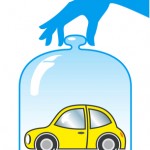Ohio car insurance laws are mandatory, but very simple and specific. Learn how to comply with Buckeye State rules and regulations, required liability limits, and also pay lower auto insurance rates through our website. We summarize the important facts so you can drive safely and legally. The law says you have to pay for accidents you cause, and we explain how to stay financially responsible as inexpensively as possible. It is illegal to drive a vehicle without insurance, or to allow another driver operate the vehicle without coverage.
It is not legal to drive your vehicle without being “financially responsible” or maintaining the proper insurance. It is also not legal to allow another driver operate your uninsured vehicle. You must either purchase a conventional policy or secure a certificate of financial responsibility (rarely used). Your ID card should always accompany you and/or the vehicle. However, if you don’t have proof of coverage at the time of a traffic stop, you will have the opportunity to present the ID in court or when you pay the fine.
Your carrier can easily email, fax, or send you a copy of a declarations page or ID card. Minimum vision requirements include 20/40 vision for an unrestricted driver. 70 degrees of side vision for each eye is also required. Class D, motorcycle, and motorized bicycle requirements slightly vary. Since your vision can rapidly change, vision exams are recommended every two years. Often, prescription glasses may be required to be worn while you drive. Failure to drive with required glasses or contacts can result in a fine.
Policy Liability Limits
When you purchase coverage, you will be asked to select your “liability limits”. The previous minimum amounts (bodily injury limits of $12,500 per person, $25,000 per occurrence and $7,500 of property damage) have been increased to $25,000/$50,000/$25,000. Optional medical payments benefits will also be offered along with uninsured motorists protection and other additional riders. Electing higher limits is financially responsible, and could ultimately save you thousands of dollars in potential out-of-pocket costs. The cost of increasing bodily injury and property damage limits is typically nominal.
Typically, policyholders can increase or decrease their liability limits and property damage limits at any time. Leased vehicles may require increasing existing limits. $100,000/$300,000/$50,000 is typically the minimum allowed limit.When purchasing an excess-liability umbrella rider, increased limits may also be required. It’s possible that $250,000/$500,000/$100,000 limits may be required. Multiple rental properties and/or youthful drivers can result in a higher premium.
Your “declarations page” is a snapshot of your rate, liability limits, and other policy features. Typically, it is sent to you annually or every six months, depending on the policy period. Policy endorsements and countersignature dates are also found on the document. Driver and vehicle (year, make, model, and VIN) information is also shown, along with policy exclusions, discounts, and surcharges. The policy number, policy period, name of agent, excluded drivers, and countersignature date are also listed on the page. Changes to the policy will generate a new page to be sent.
Current Required Limits
Thankfully, the law was changed to increase the limits. A bill was signed by then-Governor John Kasich in 2012 that became effective in March of 2013 for both existing policies and new contracts that are issued. The new minimum limits (as previously discussed) became $25,000 per person and $50,000 per occurrence, with another $25,000 of property damage. The new law was effective with a nine-month grace period that ended at the end of 2013. Carriers provided customers with ample notice that there coverage may be increasing.
 Don’t Gamble With Low Liability Limits
Don’t Gamble With Low Liability LimitsAlthough these coverages will keep you “legal,” they are nevertheless fairly low and offer very little protection. You are held legally responsible for damages caused that are not covered by the policy. At the earliest renewal of your policy, higher limits (perhaps $50,000/$100,000 and $50,000) should be considered. Otherwise, any assets you have could be taken away from you in the event of an at-fault accident where you harm someone or destroy property. And many new cars on the road cost more than $25,00 to replace.
If you are involved in a multi-car accident that is your fault, $25,000 definitely will not be sufficient. And since property damage also consists of homes, trailers, signs and buildings, it is very easy to exceed the required limit if you hit other objects. If your coverage is insufficient, you could be forced to make restitution for many years. Raising your bodily injury and/or property damage coverage may be the best investment you ever make!
Medical payments coverage will pay expenses for yourself or any other occupant of your vehicle. Since your personal healthcare benefits (group or private) likely have a deductible and coinsurance to meet, adding this optional benefit is highly encouraged. Limits of either $5,000, $10,000 or $25,000 are common amounts. Also, regardless which party was at-fault, benefits are still paid, up to the specified limits.
Your Rights
You have many rights as an Ohio car insurance customer. When your premiums are paid and you adhere to all policy provisions, you can not be discriminated against for reasons of creed, religion, race or any physical illness or injury that does not impact your driving. Of course, a copy of the policy must be provided with a copy of any form or document that was initialed or signed by yourself or an agent or broker.
If your policy is going to be terminated or not renewed, you must be notified in writing, and provided specific reasons why the policy is being canceled. Your carrier may also allow you to appeal the decision with the company underwriter. You, the insured, may cancel the contract at any time, even if the anniversary date has not arrived.
However, an early termination charge may apply. NOTE: Although terminating a policy may leave a driver non-compliant (and subject to applicable penalties and fines), the insurer does allow the transaction. It is the responsibility of the vehicle owner to remain compliant, and obtain appropriate benefits if they terminate an existing policy.
The Claims Process
Also, When filing a claim, typically, you can choose the body shop or dealership where the vehicle should be repaired, unless the policy provisions state otherwise. If you receive an offer, it must be fair, and you have the right to negotiate that offer with the claims representative or an adjuster. Arbitration may also be allowed. Utilizing an expert on the market value and repair costs of your vehicle also may save you time and money.
Of course, there are specific obligations the consumer has, including reporting accidents as quickly as possible (safety comes first), allowing the claims adjusters to have access to the affected vehicles, notifying the carrier of any applicable correspondence regarding litigation, and not filing reports on damage that never occurred! Any damage should not be altered or repaired until an authorized representative of the insurance company inspects the vehicle or authorizes repair.
NOTE: If you have been unfairly treated, or feel you are a victim of abuse and/or fraud, you can contact the Ohio DOI. You may formally notify them via email, online, or a hard copy through the mail. Their direct phone number is (800) 686-1526. The complaint center web link is located here.
Bonds
There are alternatives to buying car insurance in Ohio, but you may not like them. If you have $30,000 in liquid cash, you can deposit that, or government bonds of equal value, with the State. Or, if you can prove that you own at least 25 vehicles and self-insure them, you can also avoid purchasing coverage. Naturally, simply buying a cheap policy is the easiest option. The cost may be a lot lower than you realize.
 We’ll Help Find The Cheapest Rates
We’ll Help Find The Cheapest RatesHowever, if you are caught driving without insurance, the penalties can be severe. For instance, if you receive a moving violation or are involved in an accident, you must show proof of coverage. A declarations page or ID card should always be placed in the glove compartment. If you were not insured, your license will be suspended.
Suspensions
If it is your first or second license suspension, you may still be able to retain limited driving privileges. If this occurs, we’ll still provide quotes on how much your premium will be, and of course we’ll shop for the lowest rate. Many companies offer special policies that are much less costly than their competitors. And monthly payment arrangements are always available (see installment plan below). The most common types of suspensions are : Random selection, non-compliance, judgment, security, alcohol and drug-related, juvenile, CDL, fees, and court.
A license forfeiture suspension occurs when a person fails to appear in court (or pay a required fine) after a charge of a first, second, third, or fourth degree misdemeanor. A CDL suspension occurs when convicted of specific violations. Driving is not permitted during this time. Alcohol-relate offenses result in a 12-month license disqualification. A second offense results in permanent loss of a license.
If you have had your license suspended more than twice, you will have to pay a reinstatement fee, file an SR-22 bond and perhaps satisfy other requirements before getting back on the road. It will be the decision of the judge/court in the area where you live (assuming they have jurisdiction) that determines your fate. An experienced attorney can often negotiate more favorable terms regarding fines and reinstatement. The cost of a competent attorney will vary, depending upon where you live. The reinstatement process includes serving the court-determined suspension, pay the required reinstatement fee, and provide proof of compliant insurance when the suspension period is over.
Ohio Motorcycle And Motor Scooter Insurance Laws
Any person driving a motor scooter or motorcycle on a public road is required to have an active endorsement or a valid motor scooter or motorcycle license. This is not required for off-road activities and operating on personal property. If a rider does not have a current driver’s license, a motor scooter or motorcycle license is available. After one year, the “novice” status is removed.
If the license has a motor scooter or two-wheeled motorcycle endorsement, a two and three-wheeled motorcycle or motor scooter may be driven. A TPIC (Temporary Instruction Permit Identification Card) is available to persons aged 15 1/2 (or above) that pass a motor scooter or motorcycle test exam. Driver exam stations are located throughout the state where a vision and knowledge test must be taken. Applicants who fail the exam may re-take an exam 24 hours later. The TPIC is valid for 12 months.
Help To Pay Your Fees
An installment plan has been instituted to help persons that meet all requirements with the exception of the fees. As a result of the change, drivers can easily get retested or be classified as “valid.” To be eligible for this new program, you must have more than $150 in fees, be currently insured and show proof of coverage, and not on a court-ordered fee-payment arrangement.
If you use this payment plan, the lowest amount you can pay is $50 every 30 days, although you can pay more often. But you always must submit at least one payment every 30 days, even if you submitted two or more in the previous cycle. A payment voucher coupon will be sent to you after each payment is received. A final statement will also be mailed after you have met all obligations and paid your balance in full.
It is possible that your license will be suspended longer than anticipated. But you’ll feel the pain in the pocketbook too when you see how high your car insurance rates go up. Just about all Ohio companies will consider you a “high risk” driver. We’ll work with you to reduce the rates as quickly as possible. Prices, of course, will vary, depending where you live. Auto insurance rates in Cincinnati are usually fairly low, but add a few DWIs, and even they will be high.
Watch Your Mail
 Be Ready For Spot Inspections
Be Ready For Spot InspectionsThere is also the “Random Selection” program that could possibly affect you. Just as the name suggests, randomly, (about 20,000 vehicles per month) drivers receive a notice in the mail requesting proof of coverage. Do NOT ignore this notice because you could receive an additional letter that gives you 60 days to provide the requested information or you face a driving suspension. And they are not short suspensions!
I have actually received these random notices and if you provide a declarations page or required ID card, no action is taken. Remember, that if you receive one, you have done nothing illegal. It is completely random and has no effect on the premiums you pay. If you drive long enough, you may receive several during your lifetime.
Online Changes
Many changes that you may need to make, can be taken care of online at the Ohio Bureau Of Motor Vehicles website. Some of those tasks include renewing or personalizing your license plate, changing your address, obtaining a copy of your driving record, checking on what is needed to reinstate a suspended license and scheduling a driving exam. Although this list is just a portion of the online services, you can often visit a local license bureau for many of the services.
And finally, occasionally, you may be asked (or it may be a good idea) to buy an SR-22 Bond. So what is it? It’s an insurance policy with the absolute lowest-allowed liability limits that covers only a single driver. It will not cover any other person that drives and also will not provide physical damage to the vehicle that is being used. Insurers and many brokers can issue these policies but it’s best to discuss the coverage and rate before you consider buying it. Once your requirement period has expired, your premiums should reduce.
PAST UPDATES:
Starting tomorrow (December 22nd), the new higher liability limits (from previously passed legislation) will be effective. Bodily injury per person and per accident limits will increase to $25,000 and $50,000 with property damage also increasing to $25,000. This is the first required increase since 1969.
Although only 1 in 20 drivers carry the current minimum limits, it still creates higher rates for other persons that pay for “underinsured” motorists and medical payments protection.
Google’s self-driving car is receiving a lot of attention and has been reportedly been tested in many states including our own. While it’s not legal or ready for private or commercial use, the elimination of human error could potentially reduce car insurance rates in Ohio. Nobody knows how much, but a 10%-20% reduction is possible.
With no human decision-making, the number of accidents could substantially reduce. All blind spots are covered and the car manufacturer may be liable for potential property damage instead of the vehicle owner. It’s still years away from a reality but we’ll keep you informed.
Senate Bill 255 was passed which now gives vehicle owners the ability to verify proof of liability insurance through their electronic mobile devices, which include iPads and Smart Phones. Previously, it was required to either fax, send or provide in person a copy of the declarations page. Senator Edna Brown was the sponsor of this piece of legislation.
Startling statistic: Two out of every three accidents involving large commercial vehicles are the fault of reckless drivers attempting to pass. Recently, Ohio State Troopers participated in a two-day focus on I-70 and I-75, in an effort to monitor this high-traffic area. Other states were also involved in similar operations.
Comments on this entry are closed.